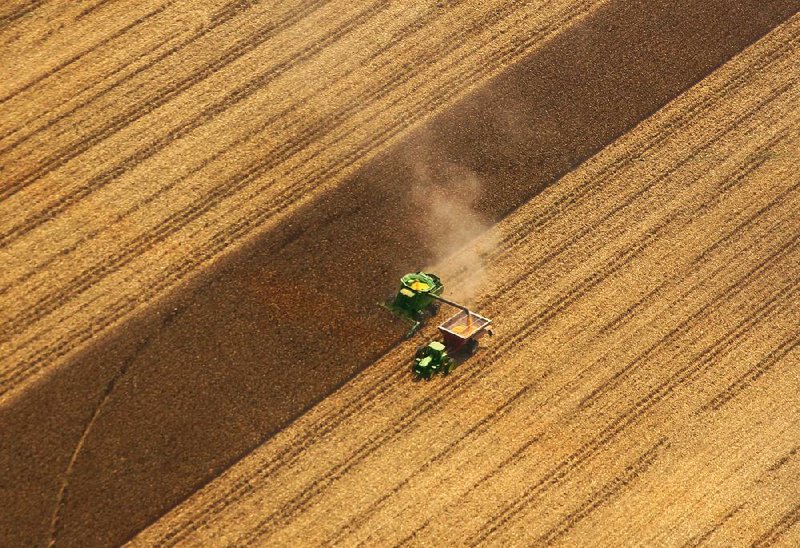Arkansas row crop farmers are likely to add grain sorghum acreage this spring as they try to deal with harvest-time price shifts for other commodities including corn, cotton and soybeans.
Jason Kelley, a grain agronomist with the University of Arkansas System Division of Agriculture, said Monday that he won't be surprised to see the state's grain sorghum acreage double from the 165,000 acres planted in 2014. He said export demand, combined with relatively low corn prices, are behind the expected shift.
"Every year there's always one crop that looks a little bit better. This year, it's grain sorghum," Kelley said Monday.
Even at double the acreage in Arkansas, grain sorghum, also known as milo, won't be a big player compared with other crops, such as soybeans and rice. Growers harvested 3.21 million acres of soybean and 1.48 million acres of rice in 2014. Producers also harvested 530,000 acres of corn and 330,000 acres of cotton last year.
The U.S. Department of Agriculture's National Agricultural Statistics Service is expected to release its planting estimates today for principal crop acreage in Arkansas and around the country based on producer surveys.
Kelley said farmers deciding what to plant are dealing with issues including commodity prices, projected demand and this spring's early cool, wet weather.
"It's kind of an odd situation. If you look at budgets for all of these crops -- I mean cotton, corn, soybeans, rice -- none of them look all that great," Kelley said.
Arkansas' corn acreage, which shrank by 39 percent from 2013 to 2014, could drop again. Farmers are also expected to plant less cotton because of low prices and a worldwide supply glut.
"Right now, grain sorghum is up almost $1 more than corn, which is unheard of," Kelley said.
Arkansas growers produced 16 million bushels of grain sorghum in 2014, up 26 percent from a year earlier. They produced 99.1 million bushels of corn last year.
At one time, grain sorghum was a bigger crop in Arkansas. In 1985, growers planted a record 940,000 acres of the grain.
On Monday, one Arkansas dealer was buying grain sorghum for May delivery at $4.90 per bushel, compared with $4.09 per bushel for corn. Another dealer was offering $4.60 per bushel for sorghum and $4.07 per bushel for corn.
Kelley said China is behind the potential rise in grain sorghum plantings.
"In Arkansas, being right on Mississippi River, just about all of our grain sorghum gets exported," he said. In states west of Arkansas, grain sorghum is used at feed lots or to produce ethanol. "Ours is all going downriver to China."
China is expected to increase its imports by 68 percent in the 2014-15 trade year, according to a report released earlier this month by the USDA's Foreign Agricultural Service. China mostly uses grain sorghum to feed livestock such as cattle and hogs. It's expected to import 7.7 million tons, compared with about 4.6 million tons in 2013-14.
Demand is expected to help exporters such as the United States, Argentina and Australia. U.S. growers could see exports rise 28 percent, from 6.4 million tons to about 8.3 million tons.
In the first six months of the 2014-15 trading year, commitments for U.S. grain sorghum has reached 300 million bushels, including 288 million from China alone, matching the USDA's export estimate for the entire year, the Sorghum Checkoff group reported earlier this month. At the same time, buyers from Japan, Canada and Mexico are also driving demand.
Wendell Stratton of Stratton Seed Co. in Stuttgart agreed that corn prices are driving the interest in the switch to grain sorghum.
On Monday, Stratton said that he's seeing increased interest and demand for the seed.
"I know of one corn grower last year who had significant acres of his total acres in corn production," Stratton said. "I was told recently he canceled his corn booking and was going to put all those acres in grain sorghum."
He said growers who don't have adequate on-farm storage have to deal with grain traders to sell newly harvested crops in a timely fashion. "And, right now, there seems to be good demand for grain sorghum."
The amount of acreage devoted to specific crops won't be known for sure until it's actually time to plant, Stratton said. While there will be some shifts to grain sorghum, some corn acreage will shift to soybeans, he said.
"It's hard to know what will happen until they literally put it in the ground," Stratton said.
And the timing for when a field is ready to plant will also play a role, he said, adding producers need good, dry weather to get their crop in the ground. "This is the week that we like to be full bore planting rice, corn and milo or grain sorghum, but we're not."
"Today is a beautiful day. It's a good drying day." said Stratton. "We have some folks that I'm sure will put some corn and grain sorghum in the ground today in some well-drained soils."
Business on 03/31/2015

